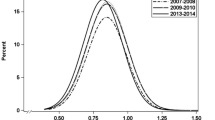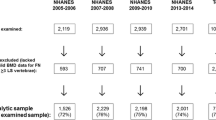Abstract
Peak bone mineral density (BMD) is one of the most important factors influencing the development of osteoporosis. It was predicted that a 10% increase in peak BMD will delay the onset of osteoporosis by 13 years. However, changes in peak BMD over time are unknown. This study aimed to investigate secular trends in peak BMD among young adults in the United States. Based on the National Health and Nutrition Examination Survey from 1999–2018, 3,975 males aged 19–28 years and 2370 females aged 31–40 years were our target population for estimating peak lumbar spine BMD. BMD was measured by dual-energy X-ray absorptiometry. Generalized linear models adjusted for multiple covariates were used to examine the secular trends in peak BMD in males and females, respectively. Secular trends for peak lumbar spine BMD from 1999–2000 to 2017–2018 were not statistically significant in males or females (all Plinear and Pquadratic > 0.05). Similar results were observed in race/ethnicity subgroups (all Plinear and Pquadratic > 0.05). However, in stratified analyses by obesity category, peak lumbar spine BMD in obese males and females increased from 1999–2000 to 2009–2010 and then decreased until 2017–2018, while peak lumbar spine BMD in non-obese females decreased from 1999–2000 to 2005–2006 and then increased until 2017–2018 (all Pquadratic < 0.05). Peak lumbar spine BMD was greater in obese males and females than in non-obese males and females up to 2009–2010, but not from 2011–2012 onwards. Overall, there were no significant secular trends in peak lumbar spine BMD. However, secular trends differed between obese and non-obese groups.



Similar content being viewed by others
References
Heaney RP, Abrams S, Dawson-Hughes B, Looker A, Marcus R, Matkovic V, Weaver C (2000) Peak bone mass. Osteoporos Int 11:985–1009. https://doi.org/10.1007/s001980070020
Tonnesen R, Schwarz P, Hovind PH, Jensen LT (2016) Physical exercise associated with improved BMD independently of sex and vitamin D levels in young adults. Eur J Appl Physiol 116:1297–1304. https://doi.org/10.1007/s00421-016-3383-1
Lorenzo JA, Canalis E, Raisz LG (2007) Metabolic bone disease. In: Kroenberg HM (ed) Williams textbook of endocrinology, 11th edn. Saunders, Philadelphia, pp 1373–1410
Hernandez CJ, Beaupre GS, Carter DR (2003) A theoretical analysis of the relative influences of peak BMD, age-related bone loss and menopause on the development of osteoporosis. Osteoporos Int 14:843–847. https://doi.org/10.1007/s00198-003-1454-8
Kanis JA, Johnell O, Oden A, Jonsson B, De Laet C, Dawson A (2000) Risk of hip fracture according to the World Health Organization criteria for osteopenia and osteoporosis. Bone 27:585–590. https://doi.org/10.1016/s8756-3282(00)00381-1
Xu Y, Wu Q (2018) Decreasing trend of bone mineral density in US multiethnic population: analysis of continuous NHANES 2005–2014. Osteoporos Int 29:2437–2446. https://doi.org/10.1007/s00198-018-4648-9
Chen C, Chen Q, Nie B, Zhang H, Zhai H, Zhao L, Xia P, Lu Y, Wang N (2020) Trends in bone mineral density, osteoporosis, and osteopenia among U.S. adults with prediabetes, 2005–2014. Diabetes Care 43:1008–1015. https://doi.org/10.2337/dc19-1807
Fan K, Lv F, Li H, Meng F, Wang T, Zhou Y (2023) Trends in obesity and severe obesity prevalence in the United States from 1999 to 2018. Am J Hum Biol 35:e23855. https://doi.org/10.1002/ajhb.23855
Cao JJ (2011) Effects of obesity on bone metabolism. J Orthop Surg Res 6:30. https://doi.org/10.1186/1749-799x-6-30
Rinonapoli G, Pace V, Ruggiero C, Ceccarini P, Bisaccia M, Meccariello L, Caraffa A (2021) Obesity and bone: a complex relationship. Int J Mol Sci. https://doi.org/10.3390/ijms222413662
Xue S, Kemal O, Lu M, Lix LM, Leslie WD, Yang S (2020) Age at attainment of peak bone mineral density and its associated factors: The National Health and Nutrition Examination Survey 2005–2014. Bone 131:115163. https://doi.org/10.1016/j.bone.2019.115163
Xue S, Zhang Y, Qiao W, Zhao Q, Guo D, Li B, Shen X, Feng L, Huang F, Wang N et al (2021) An updated reference for calculating bone mineral density T-scores. J Clin Endocrinol Metab 106:e2613–e2621. https://doi.org/10.1210/clinem/dgab180
Jung KJ, Chung CY, Park MS, Kwon SS, Moon SY, Lee IH, Kim KH, Lee KM (2016) Different reference BMDs affect the prevalence of osteoporosis. J Bone Miner Metab 34:347–353. https://doi.org/10.1007/s00774-015-0676-0
Yetley EA, Pfeiffer CM, Schleicher RL, Phinney KW, Lacher DA, Christakos S, Eckfeldt JH, Fleet JC, Howard G, Hoofnagle AN et al (2010) NHANES monitoring of serum 25-hydroxyvitamin D: a roundtable summary. J Nutr 140:2030s–2045s. https://doi.org/10.3945/jn.110.121483
Centers for Disease Control and Prevention (2007) National Health and Nutrition Examination Survey (NHANES) dual energy X-ray absorptiometry (DXA) procedures manual. https://wwwn.cdc.gov/nchs/data/nhanes/2007-2008/manuals/manual_dexa.pdf. Accessed 10 September 2021
Centers for Disease Control and Prevention (2018) National Health and Nutrition Examination Survey (NHANES) Body composition procedures manual. https://wwwn.cdc.gov/nchs/data/nhanes/2017-2018/manuals/Body_Composition_Procedures_Manual_2018.pdf. Accessed 10 September 2021
Wahner HW, Looker A, Dunn WL, Walters LC, Hauser MF, Novak C (1994) Quality control of bone densitometry in a national health survey (NHANES III) using three mobile examination centers. J Bone Miner Res 9:951–960. https://doi.org/10.1002/jbmr.5650090621
Hologic Incoporated Company (2011) Practical considerations when replacing a DXA system. https://hologiced.com/wp-content/uploads/2018/06/Wilson-KE.-Practical-Considerations-When-Replacing-a-DXA-System.pdf. Accessed 19 January 2024
Looker AC, Sarafrazi Isfahani N, Fan B, Shepherd JA (2017) Trends in osteoporosis and low bone mass in older US adults, 2005–2006 through 2013–2014. Osteoporos Int 28:1979–1988. https://doi.org/10.1007/s00198-017-3996-1
Centers for Disease Control and Prevention (2008) National center for health statistics: technical documentation for the 1999-2004 dual-energy X-ray absorptiometry (DXA) multiple imputation data files. https://wwwn.cdc.gov/Nchs/data/nhanes/dxa/dxa_techdoc.pdf. Accessed 10 September 2021
Dunnett CW (1955) A multiple comparison procedure for comparing several treatments with a control. J Am Stat Assoc 50:1096–1121. https://doi.org/10.1080/01621459.1955.10501294
Turcotte AF, O’Connor S, Morin SN, Gibbs JC, Willie BM, Jean S, Gagnon C (2021) Association between obesity and risk of fracture, bone mineral density and bone quality in adults: a systematic review and meta-analysis. PLoS ONE 16:e0252487. https://doi.org/10.1371/journal.pone.0252487
Qiao D, Li Y, Liu X, Zhang X, Qian X, Zhang H, Zhang G, Wang C (2020) Association of obesity with bone mineral density and osteoporosis in adults: a systematic review and meta-analysis. Public Health 180:22–28. https://doi.org/10.1016/j.puhe.2019.11.001
Weaver CM, Gordon CM, Janz KF, Kalkwarf HJ, Lappe JM, Lewis R, O’Karma M, Wallace TC, Zemel BS (2016) The National Osteoporosis Foundation’s position statement on peak bone mass development and lifestyle factors: a systematic review and implementation recommendations. Osteoporos Int 27:1281–1386. https://doi.org/10.1007/s00198-015-3440-3
Yang L, Cao C, Kantor ED, Nguyen LH, Zheng X, Park Y, Giovannucci EL, Matthews CE, Colditz GA, Cao Y (2019) Trends in sedentary behavior among the US population, 2001–2016. JAMA 321:1587–1597. https://doi.org/10.1001/jama.2019.3636
Shan Z, Rehm CD, Rogers G, Ruan M, Wang DD, Hu FB, Mozaffarian D, Zhang FF, Bhupathiraju SN (2019) Trends in dietary carbohydrate, protein, and fat intake and diet quality among US adults, 1999–2016. JAMA 322:1178–1187. https://doi.org/10.1001/jama.2019.13771
Juul F, Parekh N, Martinez-Steele E, Monteiro CA, Chang VW (2022) Ultra-processed food consumption among US adults from 2001 to 2018. Am J Clin Nutr 115:211–221. https://doi.org/10.1093/ajcn/nqab305
Krishnan C, Choksi P, Peterson MD (2017) Abdominal adiposity and low physical activity are independently and inversely associated with bone mineral density. Obes Res Clin Pract 11:740–746. https://doi.org/10.1016/j.orcp.2017.04.002
Pittenger MF, Mackay AM, Beck SC, Jaiswal RK, Douglas R, Mosca JD, Moorman MA, Simonetti DW, Craig S, Marshak DR (1999) Multilineage potential of adult human mesenchymal stem cells. Science 284:143–147. https://doi.org/10.1126/science.284.5411.143
Shen W, Scherzer R, Gantz M, Chen J, Punyanitya M, Lewis CE, Grunfeld C (2012) Relationship between MRI-measured bone marrow adipose tissue and hip and spine bone mineral density in African-American and Caucasian participants: the CARDIA study. J Clin Endocrinol Metab 97:1337–1346. https://doi.org/10.1210/jc.2011-2605
Bilgiç E, Boyacıoğlu Ö, Gizer M, Korkusuz P, Korkusuz F (2020) Chapter 6—architecture of bone tissue and its adaptation to pathological conditions. In: Angin S, Şimşek IE (eds) Comparative kinesiology of the human body. Academic Press, Amsterdam, pp 71–90
da Silva SV, Renovato-Martins M, Ribeiro-Pereira C, Citelli M, Barja-Fidalgo C (2016) Obesity modifies bone marrow microenvironment and directs bone marrow mesenchymal cells to adipogenesis. Obesity (Silver Spring) 24:2522–2532. https://doi.org/10.1002/oby.21660
Noel SE, Santos MP, Wright NC (2021) Racial and ethnic disparities in bone health and outcomes in the United States. J Bone Miner Res 36:1881–1905. https://doi.org/10.1002/jbmr.4417
Gong S, Wang K, Li Y, Zhou Z, Alamian A (2021) Ethnic group differences in obesity in Asian Americans in California, 2013–2014. BMC Public Health 21:1589. https://doi.org/10.1186/s12889-021-11612-z
Zhang Y, Tan C, Tan W (2023) BMI, socioeconomic status, and bone mineral density in U.S. adults: mediation analysis in the NHANES. Front Nutr 10:1132234. https://doi.org/10.3389/fnut.2023.1132234
Burge R, Dawson-Hughes B, Solomon DH, Wong JB, King A, Tosteson A (2007) Incidence and economic burden of osteoporosis-related fractures in the United States, 2005–2025. J Bone Miner Res 22:465–475. https://doi.org/10.1359/jbmr.061113
Yu EW, Thomas BJ, Brown JK, Finkelstein JS (2012) Simulated increases in body fat and errors in bone mineral density measurements by DXA and QCT. J Bone Miner Res 27:119–124. https://doi.org/10.1002/jbmr.506
Acknowledgements
The authors acknowledge the data from the National Health and Nutrition Examination Survey (NHANES). All data are available at the NHANES website (https://wwwn.cdc.gov/nchs/nhanes/default.aspx).
Funding
This work is supported by a research grant from the Changchun Scientific and Technological Development Program (Grant Number: 21ZGM28). LML is supported by a Tier 1 Canada Research Chair (CRC-2017–00186). This work is also supported by a research grant from the Norman Bethune Program (Grant Number: 2023B11).
Author information
Authors and Affiliations
Contributions
Conception and design (XZ and SY); data curation, formal analysis, and validation (XZ, LY and JZ); interpretation of data (all authors); drafting the article (XZ); supervision (SY, BK, LL and WL); funding acquisition (SY and BK); critically revising the article for important intellectual content (all authors); final approval of the version to be published (all authors); and agreement to be accountable for all aspects of the work (all authors).
Corresponding author
Ethics declarations
Conflict of interest
Xiaohua Zhang, Linghua Yang, Juan Zhang, Lisa M. Lix, William D. Leslie, Bo Kan, Shuman Yang are declare that they have no conflicts of interest.
Ethics Approval
The data from NHANES has been approved by the National Center for Health Statistics Research Ethics Review Board; they are Protocol #98-12, Protocol #2005-06, Continuation of Protocol #2005-06, Continuation of Protocol #2005-06, Protocol #2011-17, Continuation of Protocol #2011-17, Continuation of Protocol #2011-17, Continuation of Protocol #2011-17 (Effective through October 26, 2017), and Protocol #2018-01 (Effective beginning October 26, 2017).
Consent to Participate
Written informed consent was obtained from all participants (i.e., individual participants, legal guardians, and the parents); this can be obtained from the NHANES website (https://www.cdc.gov/nchs/nhanes/biospecimens/participants.htm).
Additional information
Publisher's Note
Springer Nature remains neutral with regard to jurisdictional claims in published maps and institutional affiliations.
Supplementary Information
Below is the link to the electronic supplementary material.
Rights and permissions
Springer Nature or its licensor (e.g. a society or other partner) holds exclusive rights to this article under a publishing agreement with the author(s) or other rightsholder(s); author self-archiving of the accepted manuscript version of this article is solely governed by the terms of such publishing agreement and applicable law.
About this article
Cite this article
Zhang, X., Yang, L., Zhang, J. et al. Secular Trends in Peak Bone Mineral Density: The National Health and Nutrition Examination Survey 1999–2018. Calcif Tissue Int 114, 480–489 (2024). https://doi.org/10.1007/s00223-024-01198-0
Received:
Accepted:
Published:
Issue Date:
DOI: https://doi.org/10.1007/s00223-024-01198-0




